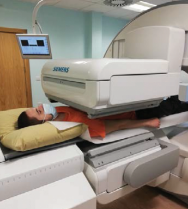Download and print as a PDF. (294kB pdf)
On this page
- What is a Tektrotyd scan?
- Can I have a Tektrotyd scan if I am pregnant or breastfeeding?
- Can I bring someone with me?
- How long will my appointment take?
- What happens before my appointment?
- Do I need to stop my medication?
- What will happen at my appointment?
- Do I need to undress for the scan?
- What happens after my appointment?
- When will I get my results?
- Are there any risks with this procedure?
- Contact details
What is a Tektrotyd scan?
A Tektrotyd scan is used to find neuroendocrine and other types of tumours, using a radioactive Octreotide which attaches to tumour cells that have receptors for somatostatin.
Can I have a Tektrotyd scan if I am pregnant or breastfeeding?
If there is a possibility that you are pregnant or if you are currently breastfeeding please inform the department before your appointment as we will likely have to reschedule.
Can I bring someone with me?
Whenever possible, you should attend your appointment alone, unless you need a carer to support any additional needs.
How long will my appointment take?
Your appointment will take 6 hours but you will have two breaks of approximately 1½ hours where you can leave the department. On occasion it may be necessary to ask you to come in the next day for further images. Please read below ‘What will happen at my appointment’.
What happens before my appointment?
For the two days prior to the scan we ask you to eat a high fibre diet and to be well hydrated. Examples of high fibre foods are: oats, chick peas, kidney beans, lentils, broccoli, cauliflower, fruits.
Do I need to stop my medication?
It is important you complete and return the enclosed form. Please list all medication that you are taking. If you are taking a somatostatin analogue (e.g. octreotide like Sandostatin or lanreotide like Somatuline) or take high insulin doses you must contact us as soon as possible. Some drugs may need to be stopped for a period of time prior to your appointment.
What will happen at my appointment?
When you arrive for your appointment, you will firstly be given a small injection of a radioactive Octreotide into a vein, usually in your arm or the back of your hand. This injection should not have any effect on you, but will allow us to take images using a gamma camera. The radioactive Octreotide will emit gamma rays which will be detected by a piece of equipment called a gamma camera.
The first set of images will be taken two hours following the injection. You may leave the department during this time and can eat normally and we will ask you to drink plenty of fluid.
When you return for your scan you will be required to lie still on your back on the imaging bed, with a gamma camera positioned above and below you, but open at both sides.
The camera will start over your head and slowly move down your body (whole body scan) which will take about 45 minutes.
Another set of images will be taken four hours after the injection. The imaging is repeated in the same way as earlier, in addition to a SPECT / CT which is a 3-dimensional (3D) image of a specific area of your body. It is important that you remain as still as possible, while relaxed and breathing normally. This session may last up to two hours.
All images will be checked before you leave the department. Occasionally images may be repeated or extra images acquired if necessary.

Do I need to undress for the scan?
You will be asked to remove any metallic objects, such as a phone, belts, keys, underwire bra, coins or zips. You may also be asked to change into a gown.
What happens after my appointment?
After the appointment you can resume all usual activities. Eat as normal and keep well hydrated. If you have young children or pregnant friends / family please limit close contact with them for the rest of the day. You can be in the same room but avoid sitting close to each other for long periods. This is to avoid them receiving any unnecessary radiation exposure.
When will I get my results?
The report will be sent to your referring doctor. They will contact you to discuss the results. If you have any enquiries regarding your results please contact the department where the referral was originally made.
Are there any risks with this procedure?
The radioactive tracer administered will expose you to a small amount of ionising radiation. The risks from this radiation are very low and the benefits of having the results from the Tektrotyd scan greatly outweigh the risk.
Contact details
Royal Sussex County Hospital (RSCH)
Nuclear Medicine Department
Louisa Martindale Building, Royal Sussex County Hospital
Eastern Road, Brighton BN2 5BE
Telephone: 01273 696955 Ext: 64381 or 64382
This leaflet is intended for patients receiving care in Brighton & Hove or Haywards Heath.
The information in this leaflet is for guidance purposes only and is in no way intended to replace professional clinical advice by a qualified practitioner.